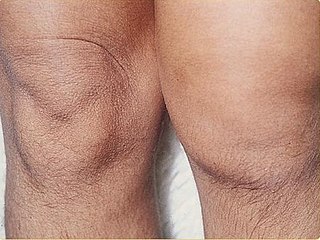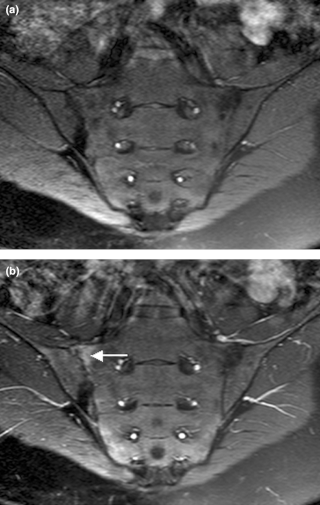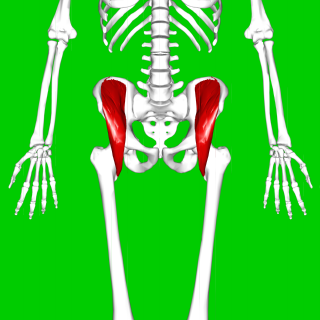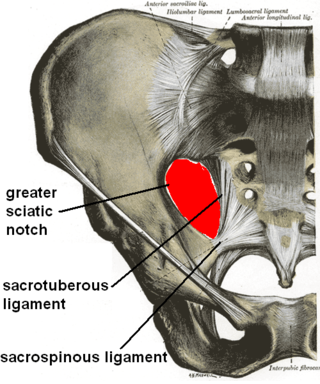
Ankylosing spondylitis (AS) is a type of arthritis characterized by long-term inflammation of the joints of the spine, typically where the spine joins the pelvis. Occasionally, areas affected may include other joints such as the shoulders or hips. Eye and bowel problems may occur as well as back pain. Joint mobility in the affected areas generally worsens over time.

Psoriatic arthritis (PsA) is a long-term inflammatory arthritis that occurs in people affected by the autoimmune disease psoriasis. The classic feature of psoriatic arthritis is swelling of entire fingers and toes with a sausage-like appearance. This often happens in association with changes to the nails such as small depressions in the nail (pitting), thickening of the nails, and detachment of the nail from the nailbed. Skin changes consistent with psoriasis frequently occur before the onset of psoriatic arthritis but psoriatic arthritis can precede the rash in 15% of affected individuals. It is classified as a type of seronegative spondyloarthropathy.

The sacroiliac joint or SI joint (SIJ) is the joint between the sacrum and the ilium bones of the pelvis, which are connected by strong ligaments. In humans, the sacrum supports the spine and is supported in turn by an ilium on each side. The joint is strong, supporting the entire weight of the upper body. It is a synovial plane joint with irregular elevations and depressions that produce interlocking of the two bones. The human body has two sacroiliac joints, one on the left and one on the right, that often match each other but are highly variable from person to person.

The dimples of Venus are sagittally symmetrical indentations sometimes visible on the human lower back, just superior to the gluteal cleft. They are directly superficial to the two sacroiliac joints, the sites where the sacrum attaches to the ilium of the pelvis. An imaginary line joining both dimples of Venus passes over the spinous process of the second sacral vertebra.

The British Rail Class 59 is a fleet of Co-Co diesel-electric locomotives built between 1985 and 1995 by the Electro-Motive Division of General Motors for use in Great Britain. A total of 15 locomotives were built for three different operators.

Reactive arthritis, also known as Reiter's syndrome, is a form of inflammatory arthritis that develops in response to an infection in another part of the body (cross-reactivity). Coming into contact with bacteria and developing an infection can trigger the disease. By the time the patient presents with symptoms, often the "trigger" infection has been cured or is in remission in chronic cases, thus making determination of the initial cause difficult.

Sacroiliitis is inflammation within the sacroiliac joint. It is a feature of spondyloarthropathies, such as axial spondyloarthritis, psoriatic arthritis, reactive arthritis or arthritis related to inflammatory bowel diseases, including ulcerative colitis or Crohn's disease. It is also the most common presentation of arthritis from brucellosis.

The iliacus is a flat, triangular muscle which fills the iliac fossa. It forms the lateral portion of iliopsoas, providing flexion of the thigh and lower limb at the acetabulofemoral joint.
Patrick's test or FABER test is performed to evaluate pathology of the hip joint or the sacroiliac joint.

The sacrotuberous ligament is situated at the lower and back part of the pelvis. It is flat, and triangular in form; narrower in the middle than at the ends.
Gaenslen's test, also known as Gaenslen's maneuver, is a medical test used to detect musculoskeletal abnormalities and primary-chronic inflammation of the lumbar vertebrae and sacroiliac joint. This test is often used to test for spondyloarthritis, sciatica, or other forms of rheumatism, and is often performed during checkup visits in patients who have been diagnosed with one of the former disorders. It is named after Frederick Julius Gaenslen, the orthopedic surgeon who invented the test. This test is often performed alongside Patrick's test and Yeoman's test.
The interosseous sacroiliac ligament, also known as the axial interosseous ligament, is a ligament of the sacroiliac joint that lies deep to the posterior ligament. It connects the tuberosities of the sacrum and the ilium of the pelvis.
A flexion test is a preliminary veterinary procedure performed on a horse, generally during a prepurchase or a lameness exam. The purpose is to accentuate any pain that may be associated with a joint or soft-tissue structure, allowing the practitioner to localize a lameness to a specific area, or to alert a practitioner to the presence of sub-clinical disease that may be present during a pre-purchase exam.
Pelvic girdle pain can be described as a pregnancy discomfort for some women and a severe disability for others. PGP can cause pain, instability and limitation of mobility and functioning in any of the three pelvic joints. PGP has a long history of recognition, mentioned by Hippocrates and later described in medical literature by Snelling.
The affection appears to consist of relaxation of the pelvic articulations, becoming apparent suddenly after parturition or gradually during pregnancy and permitting a degree of mobility of the pelvic bones which effectively hinders locomotion and gives rise to the most peculiar and alarming sensations.
Larrey's sign is a clinical sign in which patients with sacroiliitis experience pain in the sacroiliac area of the lower back on sitting down suddenly on a hard chair.

The term sacroiliac joint dysfunction refers to abnormal motion in the sacroiliac joint, either too much motion or too little motion, that causes pain in this region.

The pelvis is the lower part of the trunk, between the abdomen and the thighs, together with its embedded skeleton.
Sacroiliac joint pain or sacroiliac joint sprain are terms that may refer to:
The sacroiliac joint is a paired joint in the pelvis that lies between the sacrum and an ilium. Due to its location in the lower back, a dysfunctional sacroiliac joint may cause lower back and/or leg pain. The resulting leg pain can be severe, resembling sciatica or a slipped disc. While nonsurgical treatments are effective for some, others have found that surgery for the dysfunctional sacroiliac joint is the only method to relieve pain.

Axial spondyloarthritis is a chronic, autoinflammatory disease predominantly affecting the axial skeleton. The phrase itself is an umbrella term characterizing a diverse disease family united by shared clinical and genetic features, such as the involvement of the axial skeleton. The best-known member of the axial spondyloarthritis disease family is ankylosing spondylitis. The 2009 introduction of the expression axial spondyloarthritis made it possible to refer to (1) less severe forms of spondylitis, (2) the early phase of ankylosing spondylitis and (3) ankylosing spondylitis itself collectively.











